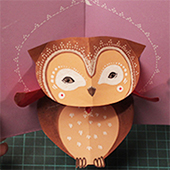Though we have records of gatefold mechanisms being used in encyclopedias in 1100, these can’t be called pop-ups in the true sense. The first known recorded use of paper mechanism was in an astrological manuscript in the year 1306. Since it was increasingly used to depict ideas in serious texts, these mechanisms were exclusively used in books for adults. Even though pop-ups were used in books, it was only in the 18th century that pop-ups were used not just as an informative tool, but also an entertaining one. This is when we find the first books with pop-ups for children. But it was only after 1810 that the golden age for pop-ups began, a lot of mass-produced paper-engineered books were created during this era for both children and adults. After a brief lull during and after world wars, the second golden age of pop-ups began in 1965 when paper engineering was used in cards and advertisements. This led to the pop-up products that we see today.
Visual timeline of important milestones with creators and creations:
1100 - Gatefold opening used to depict Globus Terre in Liber Floridus (c1121).

Ref: https://uk.pinterest.com/pin/443886106992270451/ (as seen on 4/5/2017).
1200 - Gatefold opening used for in maps of pilgrimages by Matthew Paris (1200 - 1259).

Ref: http://escholarship.org/uc/item/6g23b4fs (as seen on 4/5/2017).
1300 - Volvelles used as an organizing tool by Ramón Llull (1235 - 1316).

Ref: https://in.pinterest.com/pin/488359153312951283/ (as seen on 4/5/2017).
1540 - Volvettes used to potray the motion of the heavenly bodies in Astronomicum Caesareum by Petrus Apianus, aka Peter Bienewitz.

Ref: https://commons.wikimedia.org/wiki/File:Astronomicum_Caesareum_(1540).f14.jpg (as seen on 4/5/2017).
1765 - The first movable book for children (generically called Harlequinade) by Robert Sayer using folded paper flaps.

Ref: http://hndartandtime.blogspot.in/p/academic-essay.html (as seen on 4/5/2017).
1800 - First Golden Age of Pop-ups.
The history of little fanny, by S.J. Sayer in 1810, led a wave of using pop-up elements in books.Some of the notable publishers in 19th century were , - Earnest Nister.

Ref: http://emopalencia.com/desplegables/historia.htm (as seen on 4/5/2017) - Raphael Tuck.

Ref: http://emopalencia.com/desplegables/historia.htm (as seen on 4/5/2017)- Dean & Sons.

Ref: http://emopalencia.com/desplegables/historia.htm (as seen on 4/5/2017) - McLoughlin.

Ref: http://emopalencia.com/desplegables/historia.htm (as seen on 4/5/2017).
1888 - Internationaler Zircus, the masterpiece of Lothar Meggendorfer (1847 - 1925) was published. He created some of the most complex mechanisms in this genre.

Ref: http://emopalencia.com/desplegables/historia.htm (as seen on 4/5/2017).
1929 - True pop-ups (activated by page turning) were published by S. Louis Giraud (1879 - 1950).

Ref: http://emopalencia.com/desplegables/historia.htm (as seen on 4/5/2017).
1932 - The term pop-up was copyrighted by Blue Ribbon Press.
1950 - Vojtech Kubasta, one of the most influential pop-up book designer of 20th century starts publishing pop-up books.

Ref: http://emopalencia.com/desplegables/historia.htm (as seen on 4/5/2017).
1965 - The second golden age of pop-up begins. Graphic International started using pop ups for advertising. This company was formed by Waldo ‘Wally’ Hunt who was heavily influenced by Kubasta’s work.
1994 - The Movable Book Society is formed by Ann Montanaro for collectors, artsts, librarians and packagers.
1998 - Robert Sabuda wins the first Meggendorfer prize (awarded by the Movable Book Society) for his book “The Christmas Alphabet’.

Ref: https://bakedcottonstar.files.wordpress.com/2011/11/moma-card-2.jpg (as seen on 4/5/2017).

